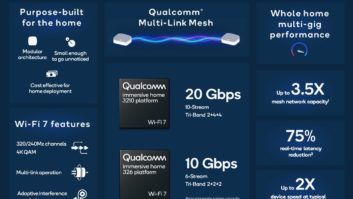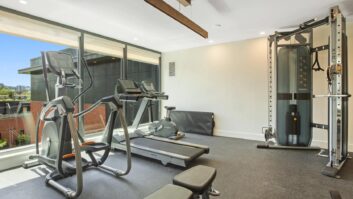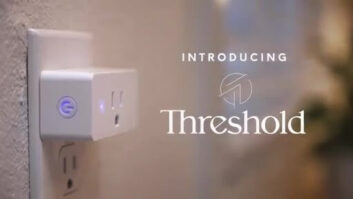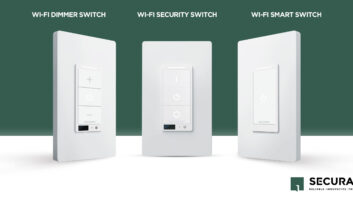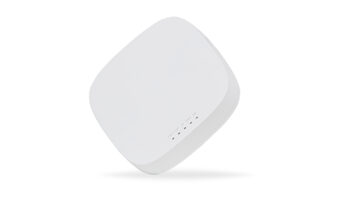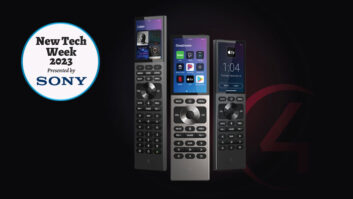Know what doesn’t come with a $5,000 HVAC system install? A decent thermostat. When my home’s system finally gave up the ghost, I was bummed at how low-end the thermostat “included with purchase” was. Sure, it was better than a mercury-ball-in-glass-tube model, but didn’t offer any scheduling, have automatic heating/cooling switchover, and wasn’t in any way “smart.”

The Honeywell RTH9590, a Wi-Fi color touchscreen programmable thermostat with voice control, looks like it belongs on the wall of a modern home, with a sleek, button-less design and customizable color themes to blend into any decor. Virtually every homeowner can benefit from a thermostat upgrade, which can quickly pay off in real dollar savings from scheduling that avoids heating/cooling an unoccupied home. For customers looking to smarten up their HVAC systems–or looking to remotely check-in on their home’s temp–the options from companies like Honeywell, Aprilaire, Lutron, Control4 and others have all been pretty traditional (ie. boring) looking. Saying Nest revolutionized the thermostat world with its innovative design, interface, and cutting edge features is no stretch. Nest also introduced the concept that a thermostat could look cool. However, Nest has been hesitant to integrate in smart automation systems, choosing to be a smart and beautiful island mostly unto itself. (Nest CEO, Tony Fadell, did announce an integration partnership with Control4 at this past CEDIA, however a control driver has still yet to appear.)
Enter the Honeywell RTH9590, a Wi-Fi color touchscreen programmable thermostat with voice control. Visually, it looks like it belongs on the wall of a modern home, with a sleek, button-less design and customizable color themes to blend into any decor. Perhaps more exciting to integrators, Honeywell is opening the Comfort Control API to several companies like Control4, Lutron, and “additional development partners” to encourage automation system integration.
Installation was a breeze thanks to a well written manual offering eight pages of different wiring possibilities, as well as an online video and live phone support line. I appreciated the screwless wire terminals, which greatly sped up terminations. After connecting the wiring, the thermostat powers up and guides you through basic settings like language, whether it’s installed in a home or business (useful for scheduling), what kind of HVAC system you’re using (for example I have a heat pump), and the number of heating/cooling stages.
After connecting to my Wi-Fi network I was directed to register the thermostat and create an account at mytotalconnectcomfort.com to enable remote access. Once completed, I downloaded the free iOS app (Android also supported) and could access the thermostat from anywhere. The site also let me set up email and/or text alerts in the event the temperature or humidity exceeds limits or if the thermostat loses internet connectivity.
In the past, thermostat scheduling was so convoluted and cumbersome few people bothered to do it. Fortunately, Honeywell greatly simplified scheduling, including a wizard that asks simple questions like, “When does the first person wake up?” “When does the last person leave?” “When does the first person return?” and “When does the last person go to sleep?” By answering those four questions a schedule is created, automatically raising and lowering temps as needed to maximize comfort and energy savings. (Scheduling can also do done manually, editing four different periods each day of the week.) There are also options for setting up vacation (home) and holiday/event (business) schedules.
The thermostat offers other advanced features, like learning how long it takes your system to heat/ cool to set temperatures, automatically switching between heating and cooling (important in areas like Myrtle Beach where 50-degree temperature changes in 24 hours isn’t unheard of), periodically running the fan to circulate air, and notifying when air filters need changing. It does not support multiple temperature sensors, however, which could be an issue in a large HVAC zone.
I loved that the thermostat displays temperature and humidity both inside and outside, as well as the time and date. It’s a simple thing, but very nice to easily get that info at a quick glance. The control app also offers a simple five-day forecast to show upcoming weather.
Voice control is the RTH9590’s unique twist. Control is initiated by saying, “Hello, thermostat,” and after the thermostat responds with, “Hello. Please say your command,” you can say things like “Make it warmer/cooler,” Make it (1-10) degrees warmer,” “I’m feeling hot/cold,” or “What is the time/date/indoor/outdoor temperature?” Like all voice control solutions, results vary based on accent, diction, volume level, and proximity. It responded correctly for me probably 90 percent of the time, but my 7-year-old daughter could rarely get it to work correctly. (To be fair, her voice gives Siri fits as well.) There is a sensitivity setting for the voice control that randomly caused the thermostat to respond to TV/movie audio when set too high.
My biggest gripe with the voice control was that it’s a little slow, taking roughly 12 seconds to complete a request. For me, walking up to it or whipping out my iPhone made more sense. However, for anyone with mobility issues or perhaps someone sight-impaired, the voice control would be a terrific solution.
With the RTH9590, Honeywell proves that there are still a few new tricks that can be added to the old thermostat dog. When companies like Lutron and Control4 start integrating with Honeywell’s API, it will be a formidable control indeed.
877.841.2840
wifithermostat.com
Kudos
Looks great; easily programmable; nice control app; open API
Concerns
Voice control is slow, doesn’t support multiple temperature sensors
Product Specs
• Works with majority of existing HVAC systems
• Control from anywhere using iOS, Android or Web interface
• Customizable touchscreen offers sleek look in any decor
• Responds to a variety of voice commands
• Integration with a variety of automation systems coming soon

